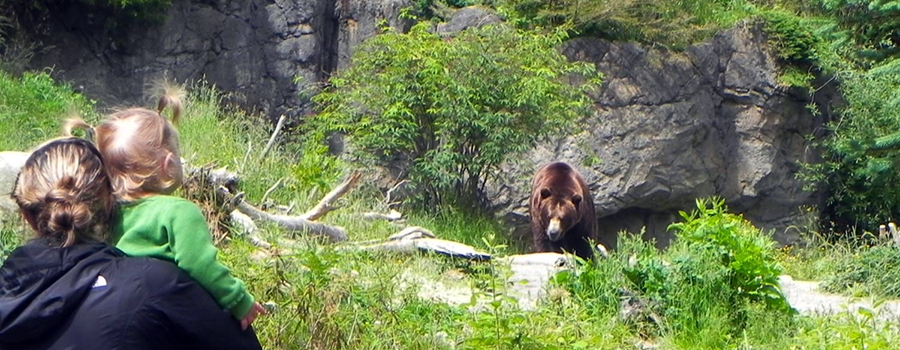Large Carnivores
Large Carnivores Exhibits
Design for large carnivores is challenging because these seem to be either pacing or sleeping. Most evolved to cover large distances in search for food and, having found it, they need to rest and digest. While there is only one paper in this section, the large carnivore exhibit section describes a wide variety of successful design ideas, including a large naturalistic immersion bear facility at Woodland Park Zoo, and a function ally naturalistic Big Cat Trail at Philadelphia Zoo.
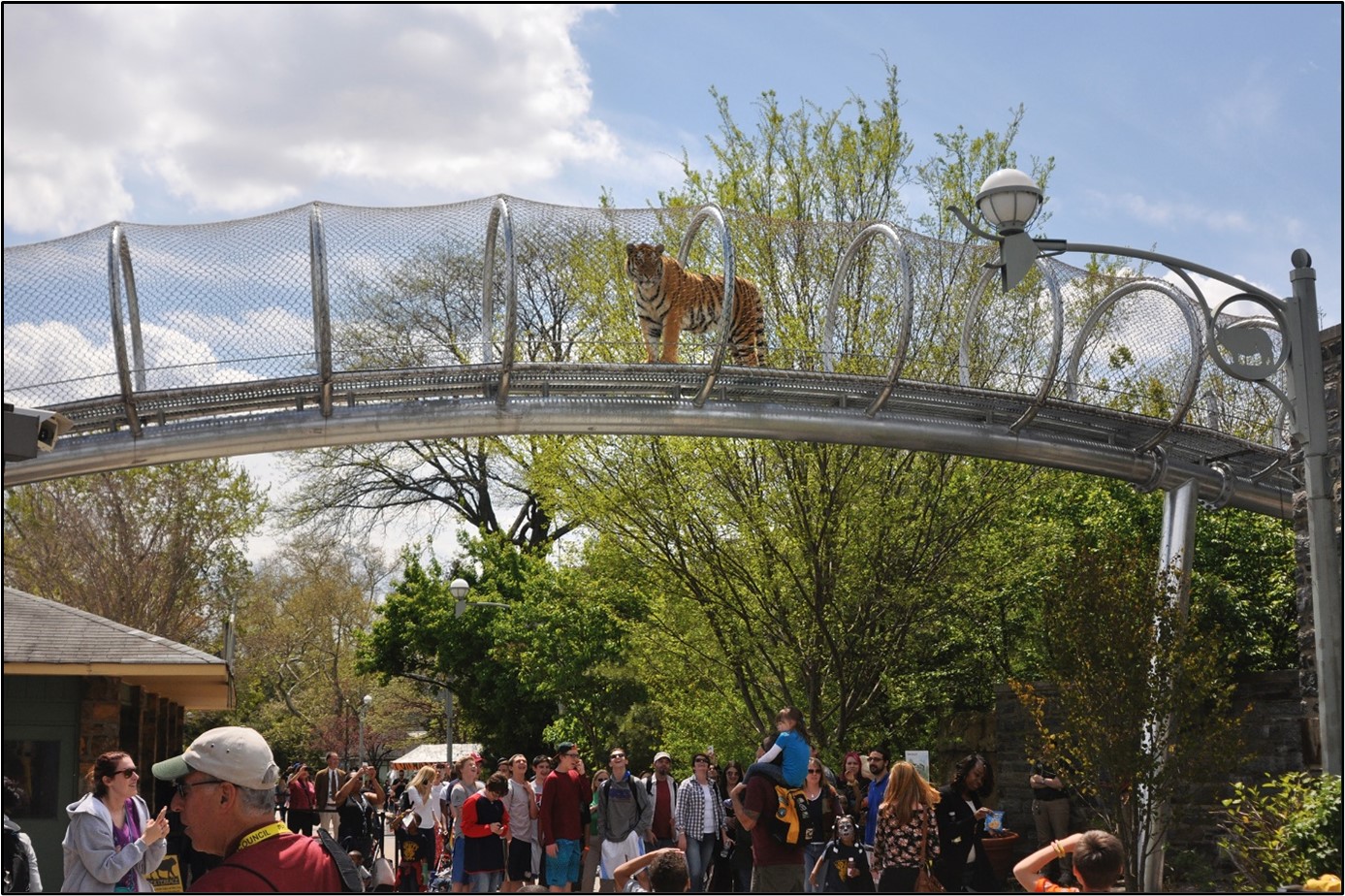
Big Cat Trail, Part of the Philadelphia Zoo 360 concept Jon suggested to Curator Andrew Baker, is over 200m long and used alternately by Amur tigers, Amur leopards, snow leopards, lions, jaguars, and cougars. Soon after opening this press photo went viral in newspapers around the world, showing the popularity of this “animal trail” approach
Papers about Large Carnivore Exhibits
Coe, Jon C., 1986. “The African Savanna Exhibit at Woodland Park Zoo” in International Zoo Yearbook, 24/25: 332-339.
Good Examples of Large Carnivore Exhibits
Zoo Atlanta Lion Exhibit
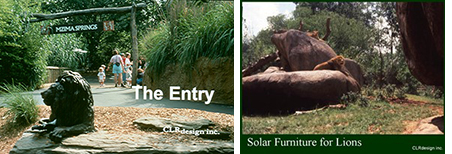
Left photo: entry to lion and other African Plains exhibits themed as an African nature reserve. Right photo: showing lions enjoying their purpose-made artificial geology “solar furniture”.
This lion exhibit designed by Jon, Gary Lee, and Nevin Lash (CLRdesign) is special for combining animal comfort with visitor viewing opportunities. Lion comfort was insured by designing their artificial rock outcrop to align with both summer and winter sun angles to provide basking areas with distant views in cool periods and shady shelters in warm or stormy periods. In addition, heating cables were embedded in the artificial rock surfaces and evaporative coolers gently blow cool moist air down into lions resting near public viewing windows during warm weather. These were located near where the lions would enter and exit the exhibit, assuring lions would be easily visible while waiting to go in for their nightly feedings. Visitor viewing areas were arranged to focus on this lion furniture where the lions would usually choose to be. Since lions frequently prefer these higher positions, visitors are encouraged to “look up to then”, encouraging a respectful public attitude. Thus, knowledge of lion natural behaviour and needs shaped exhibit design, benefiting both animals and visitors.
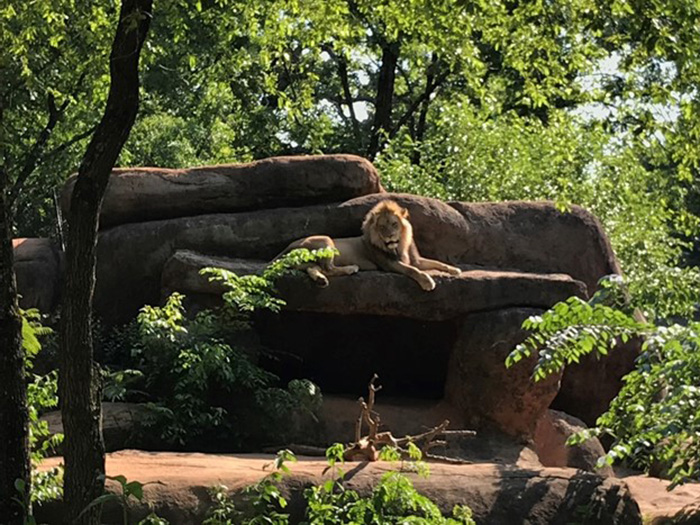
Lion enjoying the afternoon sun more than thirty years after construction. Photo: N. Lash.
- Lion Exhibit, Zoo Atlanta, Georgia, USA, 1986 CLR
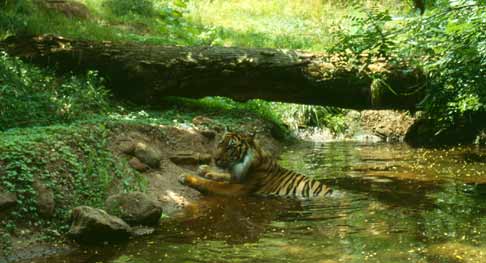
Sumatran Tiger Exhibit at Zoo Atlanta
Sumatran tiger resting in a shallow, shaded pool near the public viewing window.
Like the Zoo Atlanta lion exhibit, this area was designed to meet the animal’s wants and needs while ensuring excellent viewing opportunities.

The same area about twenty years after opening without log bridge. It is important to provide access for replacing large objects and major plantings in the future. Note use of sloping glass to reduce reflections in public viewing shelters.
Zoo Atlanta, Lion & Sumatran Tiger Exhibits, Zoo Atlanta, Georgia, 1986, CLR
Snow leopard and Amur Tiger Exhibits at Great Plains Zoo & Delbridge Museum
This small zoo in the cold climate of Sioux Falls, South Dakota wisely chose cold-hardy Amur tigers and snow leopards for their program. Jon recommended that instead of designing special buildings, they assemble a prefabricated log cabin with hidden reinforced windows mounted outside the cabin windows as a “trapper’s cabin” public view area. Inexpensive containment fencing was well hidden behind existing pine trees. This log cabin approach has also been successfully used elsewhere, for example the wolf exhibit at the Minnesota State Zoo (designed by others).
- Snow Leopard & Siberian Tiger Exhibits, Delbridge Museum and Zoo, Sioux Falls, South Dakota,1993, CLR
This Alaskan brown bear exhibit (about 1100 sqm with 410 sqm exercise yard)) is part of the Northern Trail boreal forest habitat grouping. Adjacent displays include wolves, mountain goats, wapiti (elk), river otters and snowy owls, as well as the indoor Tundra Interpretive Centre. As this video demonstrates, the exhibit leads visitors from higher ground along a stream, into a cave and to a lower pool with underwater viewing of the bears fishing for trout and interacting with visitors. These bears are brothers and sometimes have dominance disputes over who gets the preferred position next to the viewing window, as you will see near the end of this video. The Northern Trail exhibits opened in 1994 and won the American Zoo & Aquarium Exhibit Award in 1995.
- Northern Trail (Brown Bear & Wolf Exhibit), Woodland Park Zoo, Seattle, WA USA. 1995 CLR

Islands Exhibit, Louisville Zoo, 19956
The world’s first multi-species rotation exhibit, this ground-breaking concept rotates orangutan, siamang, tapir, babirusa and Sumatran tiger through four different habitats on a random basis to provide novelty and extend activity opportunities for the animals. Viewers encounter the animals in a stream-side forest behind a simulated Indonesian village.
An extensive behind-the-scenes flexible system of transfer chutes and holding areas facilitates animal movement by keepers using operant conditioning techniques. Head keeper Jane Anne Franklin was key to developing the behavioral management system in this revolutionary display. A three-year behavioral study concluded the rotation concept is non-stressful and enriching to the animals, increasing activity levels and demonstrating natural behaviors not previously observed. (See: White et al “Activity-Based Exhibition of Five Mammalian Species: Evaluation of Behavioral Changes”. Zoo Biology 22:269–285 (2003).
- Louisville Zoo, Islands Sumatran Tiger Exhibit, Louisville Zoo, Kentucky, 1995, CLR
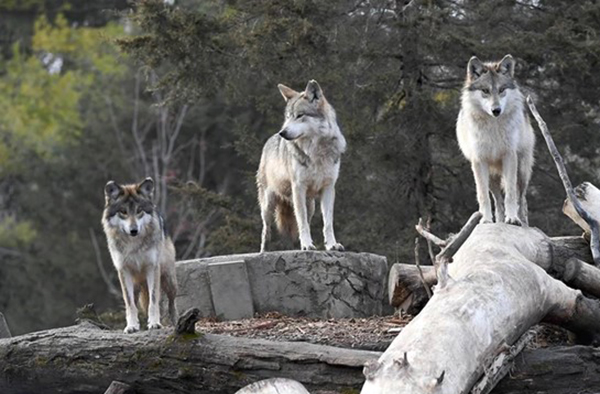
Wolf Woods Exhibit at Brookfield Zoo
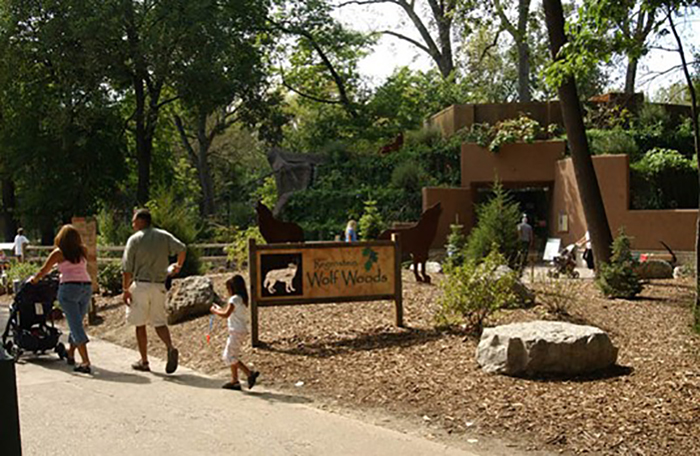
Entry area showing roof planting on viewing building a few years after planting. This planting is on elevated side areas and not actually on the roof, simplifying construction, Photos: J. Schultz.
Legendary Zoo Director Dr George Rabb and his wife Ms Mary Rabb spent many hours together studying the wolves in their old facility. Building this new facility in their honour in 2004 gave this project special importance to Jon (with CLRdesign) and to zoo project manager Dr. Tim Sullivan. The Brookfield Zoo’s program for breeding and displaying Mexican Wolves (Canis lupus bailey) for eventual release required a one acre (4000sqm) off-exhibit area plus an equal sized exhibit area. Since the offspring of these wolves may eventually be released, the staff wanted to avoid the wolves becoming too accustomed to people. For this reason, Jon designed their wolf viewing building with “on-way” or “mirror glass” so that visitors could clearly see the wolves, but the wolves couldn’t see them.
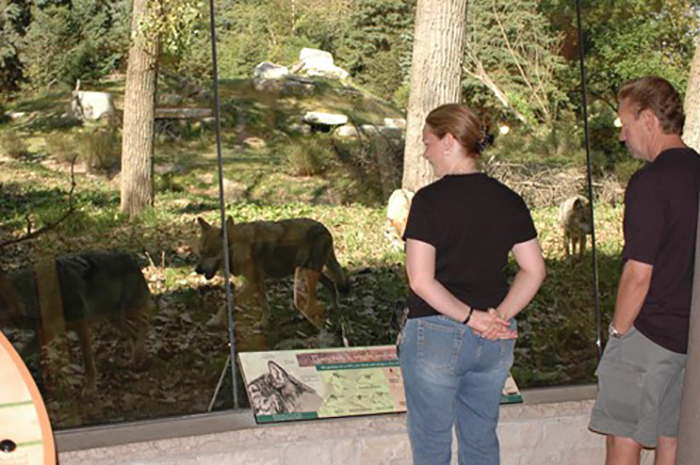
Visitor view of Mexican wolves. Note that the wolves, always very wary of people, seem not to notice the visitors behind the “one-way glass”, which is sloped to minimize reflections. The wolves’ den in the distant hillside can be observed by visitors using closed circuit TV.
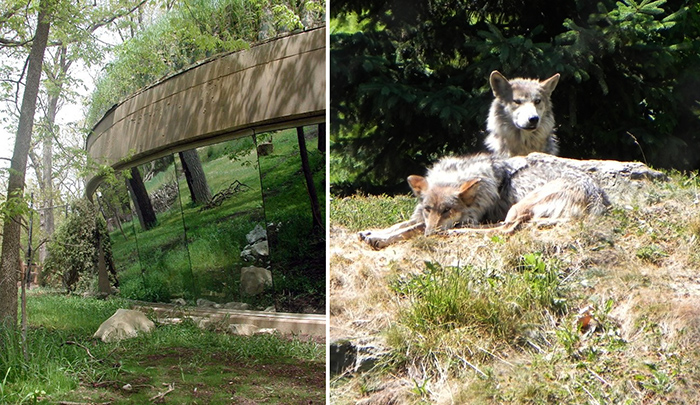
This is the wolves’ view of the “mirror glass” large windows reflecting their natural landscape. Although the wolves can hear and smell visitors, they remain undisturbed. There are also several open viewing areas much more distant from the wolves.
- Wolf Woods Exhibit, Brookfield Zoo, Chicago, Illinois, 2003, CLR
- Tiger Trail Concept Plan Taronga Zoo, Sydney, Australia, 2014, JCD
- Giant Panda Theme Park (multiple exhibits), Dongkoucao, Sichuan China, 2008, JCD/NBWL
Tsavo Lion Restaurant on Bali
Jon designed the large circular restaurant to resemble a safari park pavilion in Tsavo East National Park in Kenya, famous for the man-eating lions of the Victorian period. This restaurant, with an excellent chef, forms one edge of the lion exhibit, which is also visited by the safari tram seen in the beginning of this video. Lions can be seen from the restaurant and also from behind the bar in even from the toilets!
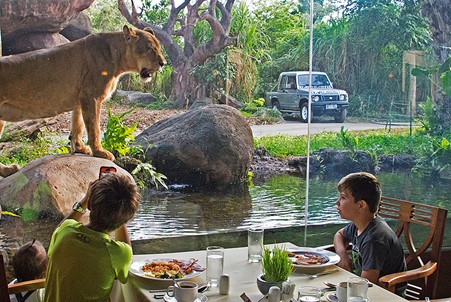
Breakfast with Lions!
- Lion Restraurant, Taman Safari, Bali, Indonesia, 2006, JCD
- Giant Panda Exhibit, Tamen Safari Indonesia, Bogor, Indonesia, 2014, JCD
Lion – Tiger Exhibits Thrissur Zoo, India
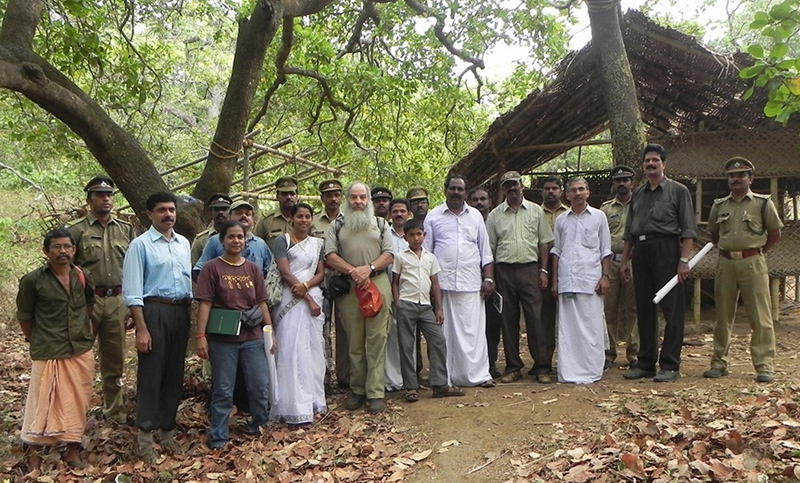
Jon meeting on-site with local village leaders, Forest Department Officials, and the local architects’ & landscape architects’ team. The woman to Jon’s left is the local mayor and the woman to her left is Ms Chitra Biley, co-owner of Idea Design. Her husband and partner Mr Biley Menon took this photo.
Jon collaborated with Idea Design of Cochin India to master plan the new Thrissur Zoo in the southern State of Kerala for the State Forest Department beginning in 2013. The zoo is expected to open later this year. Jon located the Asian lion and Bengal tiger exhibits on a steep east facing hillside above the main visitor road. In keeping with the Central Zoo Authority of India Standards and Norms the animal areas were large. The tiger exhibit provided 1544 sqm (16,620 sf) of sloping exhibit area and 602 sqm (6,480sf) of level off-exhibit area including three large exercise yards. Thus, if they had three tigers which didn’t get along, all could be in spacious exercise areas while the exhibit is being serviced or renovated. These animals could be rotated several times each day to relieve boredom. Animals will be separated into small feeding and exanimation pens briefly each day but are intended to have 24/7 access to large behaviourally enriched areas most of their lives.
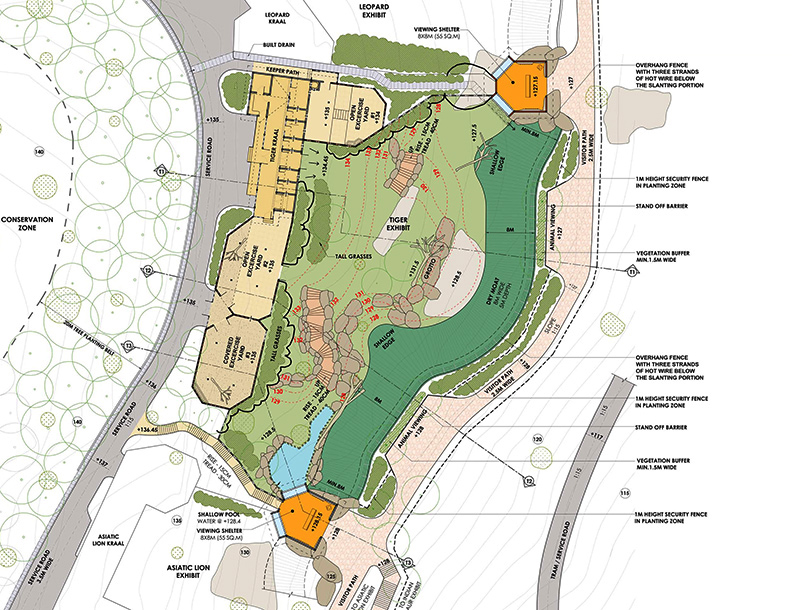
On both ends for the exhibits are covered viewing areas where visitors can see into two adjacent exhibit areas through glass windows sloped to reduce reflections. These corner locations provide carefully controlled views obscuring side barriers and creating the appearance that the two large areas are not separated. Open views for the public across a water moat are provided nearer the centre of the exhibit area. Moats are used for rainwater harvesting and designed to operate as either wet or dry moat barriers, depending upon the season. Drawing of Jon’s design by Idea Design.
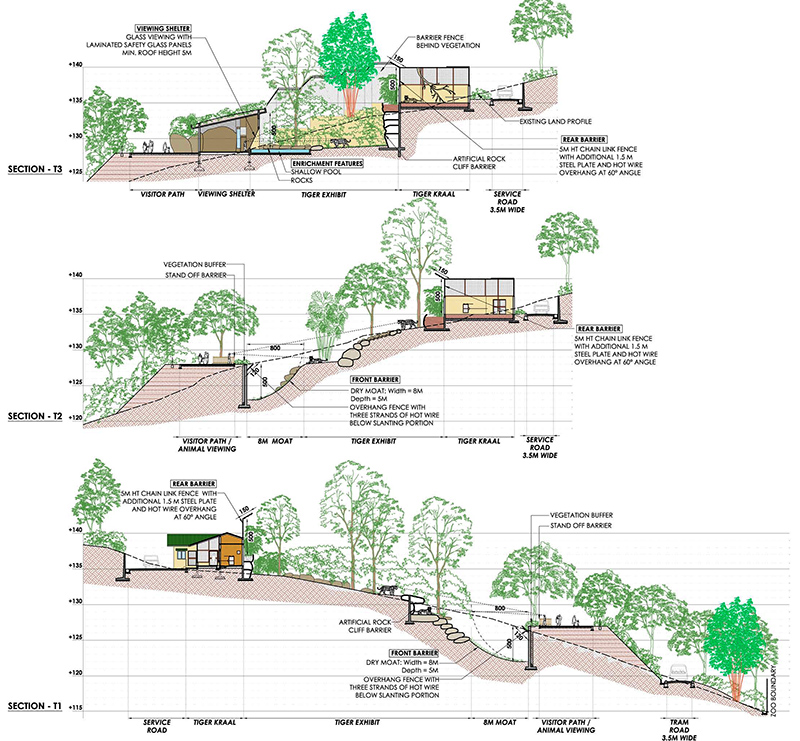
Jon developed these designs to minimize construction difficulty and environmental impact. But as this cross section shows, a large about of cut and fill, including removal of areas of granite rock, was required to shape this steep site as needed. Located in a monsoon climate area subject to seasonal deluges, site drainage and water harvesting as a particular design focus. Most of this work has now been completed and the Forest Department team are reforesting the site as the project moves towards opening. Drawings of Jon’s design by Idea Design.
- Tiger, Lion, Leopard and Bear Exhibits, Thrissur Zoo, Karola, India, 2011, JCD
- Tiger Crossing at Big Cat Trail, Philadelphia Zoo, Pennsylvaia, 2012, JCD
- Predator Leopard Ridge advisor, Melbourne Zoo, Victoria, Australia, 2016, JCD
